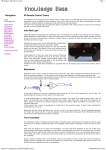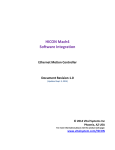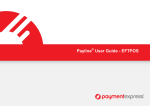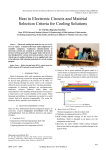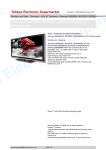Download PIO-1 User Manual
Transcript
PIO-1 User Manual Copyright © Promixis, LLC 2011,2012, 2013 The Promixis PIO-1 is a network multifunction input output device capable of sending and receiving IR codes, network to serial conversion, digital input output and relay control. It supports DHCP and static IP configuration. If you are having trouble with your PIO-1 please contact [email protected] or 877.877.0643 x 1 for help. The PIO-1 is network upgradeable using industry standard TFTP protocol. So once the PIO-1 is installed there is no need to remove it from it's installed location to upgrade. 1. Functionality The PIO is packed with features: 1. 2. 3. 4. 5. 6. 2 Serial outputs 4 IR Outputs 1 IR Input (NEC, Sony SIRC and Philips RC5, RC6 protocols supported) 3 Relays 2 bi-directional digital ports Web configuration interface 1.1. Ethernet to Serial Bridge The device outputs the raw data from the serial port onto the network without any conversion. With the addition of this free software you can use the PIO-1 as a virtual comport on your computer with any software that supports serial communications. The serial ports can be access through the network by connecting to ports 6001 (serial 1) and 6002 (serial 2) on the device. The serial port baud rates can be configured through the web interface. Some serial devices require power on pins 4 and 7 to operate properly (for example the UPB interface modules). The PIO-1 provides internal jumpers (p6 and p7) to provide that. Note that due to the inherent network behavior timing of data arrival is slightly different when using any Ethernet to Serial bridge and some time sensitive serial protocols might not work. 1.2. IR (infra red) The PIO-1 supports the industry standard RAW-CCF format and can output a wide range of modulation frequencies. The PIO-1 also has a IR input that allows you to detect remote controls using the Philips RC5, Sony SIRC or NEC IR protocol. Any universal remote will be able to send signals that the PIO-1 can recognize. 1.3. Relays The PIO-1 has three internal relays suitable for signal level switching. The relays can be controlled from the telnet and web interface. 1.4. Digital Input Output The PIO-1 has 8 digital input output lines. Two of those lines are brought out to the back of the PIO-1 on the green connector block. The external lines are protected with an ESD protection circuit. Refer to the electrical characteristics sections for the maximum draw allowed on these lines. You'll also find a 3.3V dc output on the green connector block. Please do not use more than 50mA from this. 1.5. Web Configuration Configuration of the PIO-1 can be done through a web browser. Simply type the IP address of the PIO1 into your browser. For example http://192.168.1.102. 2. The API The PIO-1 also has a telnet interface that allows you to control the various features of the device. The telnet interface can be reached on port 6000. The API is plain text and \r\n terminated. This allows you to control the PIO-1 manually as well as using an automation application like Girder. If an error occurs the unit will answer “error 0,0” 2.1. Version This commands allows you to retrieve the firmware version and the device layout. Request getversion Answer getversion Promixis PIO-1 Firmware 1.7.0,IR:4,RELAY:3,IO:2,SERIAL:2 2.2. Relays These commands give you full control over the relays. <relay> is the index of the relay either 1, 2 or 3. <state> is 0 for open and 1 for closed. Change relay status Request setrelay <relay>,<state> Answer ok Relay Status request. Request getrelay <relay> Answer getrelay <relay>,<state> 2.3. Digital IO Digital IO ports (<pin>=1-8) have three registers. A direction register, an output register and an input register. Pin's 1 and 2 are the external pins. <direction> can be 0 for input and 1 for output. <state> can be 0 for off and 1 for on. These are manipulated through the following requests. Set Direction: Request setddr <pin>,<direction> Answer ok Get Direction: Request getddr <pin> Answer getddr <pin>,<direction> Set Port (output value / pull ups) Request setport <pin>, <state> Answer ok Get Port (output value / pull ups) Request getport <pin> Answer getport <pin>,<state> Get Pin (input) value Request getpin <pin> Answer getpin <pin>,<state> Whenever the value of an input changes the unit automatically sends the following notification Noti pinchange <pin>,<state> 2.4. IR Sending IR signals can be sent using industry standard CCF codes. Since sending can take a bit of time with longer repeats or CCF codes the unit will acknowledge the request with “ok” and later send “irdone” when the sending is actually finished. Do not try to send a new IR signal before the last has finished. Request sendccf <BITMASK>,<REPEAT>,<CCF> Answer ok • • • <BITMASK> is bitmask of the 4 outputs, and accepts values between 1 and 15. If you wish to send an IR signal out the first port use bitmask 1. The second port has bitmask 2. The third port has bitmask 4 and the fourth port has bitmask 8. You can combine these in any way you like. <REPEAT> is the number of times to repeat the signal. <CCF> is the RAW-CCF code to send. Example: sendccf 15,20,0000 006E 0022 0022 0156 00A9 0015 0012 0015 003F 0015 003F 0015 003F 0015 0012 0015 003F 0015 003F 0015 0012 0015 003F 0015 0012 0015 0012 0015 0012 0015 003F 0015 0012 0015 0012 0015 003F 0015 0012 0015 003F 0015 0015 0015 0012 0015 0015 0015 0012 0015 0015 0015 0015 0015 003F 0015 0015 0015 003F 0015 003F 0015 003F 0015 003F 0015 003F 0015 003F 0015 081F 0156 00A9 0015 0015 0015 003F 0015 003F 0015 003F 0015 0015 0015 003F 0015 003F 0015 0015 0015 003F 0015 0015 0015 0015 0015 0015 0015 003F 0015 0015 0015 0015 0015 003F 0015 0015 0015 003F 0015 0015 0015 0015 0015 0015 0015 0015 0015 0015 0015 0015 0015 003F 0015 0015 0015 003F 0015 003F 0015 003F 0015 003F 0015 003F 0015 003F 0015 081F Cancelling a repeating IR signal Request stopccf Answer ok 2.5. Closing Connection Close the connection. Request exit Answer ok 2.6. Get MAC address Returns the MAC address for the unit. Request getmac Answer getmac 00:1B:C5:03:B0:01 2.7. Remote Detection The PIO-1 recognizes 3 IR protocols and notifies the listener on the telnet connection. Philips RC5 rc5 <toggle bit>,<address>,<command>\r\n Philips RC6 rc6 <toggle bit>, <address>,<command>\r\n Sony SIRC (12,15 and 20 bits) sirc <address>,<command>\r\n NEC protocol nec <address>,<command>\r\n 3. Firmware updating / Factory Reset You can update or factory reset the PIO-1 using the PIO-1 tool available from the Promixis website. 4. Unit Detection The PIO-1 will periodically transmit a UDP broadcast packet containing it's current IP address. This allows you to find PIO-1 on your network's subnet and determine which IP address the PIO-1 has taken on the network. The destination port for this broadcast is: 5998 IP address 255.255.255.255 The packet contains the string: PIO1,1.7.7,192.168.2.108,00:1B:C5:03:B0:00 which is the name, the firmware version, the ip address and it's hardware address. The Promixis PIO-1 Tool allows you to find the PIO-1's easily on the network and upgrade them as needed. You can find this tool at http://www.promixis.com/pio-1.php 5. UDP Communications The PIO-1 also responds to UDP communications on port 5999. It currently support 3 functions there. 5.1. IR Send Command Id = 0 Byte 6 → Bitmask = bitmask of ports to send from Byte 7 → Repeat = Repeat count for IR Byte 8... → Data = binary encoded CCF (big endian) 5.2. IR Stop Command Id = 1 5.3. Broadcast Presence Command Id = 2 5.4. Reset PIO-1 Command Id = 3 5.5. Reset and Upgrade PIO-1 Command Id = 4 5.6. Set Relay Command Id = 5 Byte 6 → Relay Number (1 or 2) Byte 7 → 0 = open, 1 = close. 5.7. Packet Format Bytes Contents 0 P 1 I 2 O 3 - 4 1 5 Command (0, 1, 2, 3, 4 or 5) 6 Bitmask (command 1) 7 Repeats (command 1) 8-end CCF 16 bit unsigned integers high byte first. 6. Troubleshooting If for any reason a firmware upgrade fails or you need to turn DHCP back on to get the PIO-1 back on the network use the following procedure. 1. Find a IR remote with new batteries 2. Unplug the PIO-1 3. Point the IR remote at the rectangular hole marked IR-in and press a button on the remote. 4. While holding the button on the remote power up the PIO-1. 5. The PIO-1 will now set the DHCP server option to 1 and also check if a TFTP server is available with new firmware. 7. Characteristics Power input 12v dc capable of at least 500mA. The center pin must be positive. Relay output Maximum power of 10Watts and can switch a maximum current of 0.5A and a maximum voltage of 200Vdc. Note these relays are not intended to switch AC power. Digital IO The digital inputs handle a maximum of 3.3V as input and put out 3.3V (max 10mA) in output mode. Do not put voltages larger than 3.3V on these ports. Internal Digital Lines These have the same characteristics as the external digital minus the ESD protection circuit. Power output The PIO-1 has a VCC (3.3V) + GND output on the green connector block please do not draw more than 50mA on this output. Operating Temperature 0°C to 50°C Operating Environment Indoor or water shielded operation only Ethernet 10Base-T Dimensions 5.63 x 3.75 x 1.38 in. (excluding connectors) (flanged cases available upon special request) Material Flame Retardant ABS - UL94-5VA Exceeding these specifications will damage the unit and void your warranty. All information herein is copyright © 2011,2012,2013 Promixis, LLC and subject to change without notice. For the latest version of this document please go to www.promixis.com. 211 Edenberry Avenue Jupiter, FL 33458 Tel: 877.877.0643 Fax: 805.504.9741 www.promixis.com












